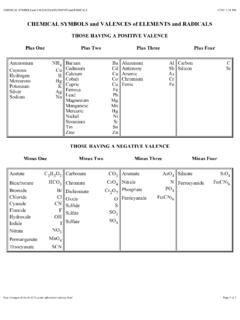Transcription of Direct observation of spin-orbit splitting and phonon ...
1 RAPID COMMUNICATIONS. PHYSICAL REVIEW B 88, 201302(R) (2013). Direct observation of spin-orbit splitting and phonon - assisted optical transitions in the valence band by internal photoemission spectroscopy Yan-Feng Lao and A. G. Unil Perera*. Department of Physics and Astronomy, Georgia State University, Atlanta, Georgia 30303, USA. L. H. Li, S. P. Khanna, and E. H. Linfield School of Electronic and Electrical Engineering, University of Leeds, Leeds LS2 9JT, United Kingdom H. C. Liu Key Laboratory of Artificial Structures and Quantum Control, Department of Physics and Astronomy, Shanghai Jiao Tong University, Shanghai 200240, China (Received 30 January 2013; published 11 November 2013). We employ internal photoemission spectroscopy to directly measure the valence-band Van Hove singularity, and identify phonons participating in indirect intervalence-band optical transitions.
2 Photoemission of holes photoexcited through transitions between valence bands displays a clear and resolvable threshold, unlike previous reports of interband critical points which become obscure in doped materials. We also demonstrate the enhancement of optical phonon - assisted features primarily contributing to the photoemission yield. This result is evidence of the relaxation of photoexcited hot holes through intravalence-band scatterings in heterojunctions, which contrast with intervalence-band scatterings in bulks. DOI: PACS number(s): , , , optical studies of light interacting with a material reveal successful photoemission, photocarriers must transfer between fundamental information about its electronic structure, the energy bands of the absorber and barrier, which leads to photons, phonons, and carrier dynamics in the material, inter remarkable features associated with indirect transitions due 4 Many fundamental studies and device applications to their higher probabilities of occurring compared to Direct make use of optical transitions between different energy Analysis of the IPE results also allows us to study bands,5 11 among which the valence-to-conduction band hole dynamics upon photoexcitation.
3 Our results broaden the (VB to CB) transitions are typically used to determine band understanding of the VBs and optical processes, which, for parameters,9 , the interband Van Hove example, may offer a better understanding of the origin of Despite the well-known electronic structure, understanding hole-mediated ferromagnetism for p-type (Ga,Mn)As,19 by of VB-related physics is still very limited. Nearly all of distinguishing IVB transitions from impurity band-to-valence what is currently understood about VBs come from optical band transitions through resolving the VB singularity. In absorption5 7 and interband transition -based experiments,9,10 addition to this fundamental interest, phonon identification the latter of which encounters a fundamental difficulty when will find applications in determining free-carrier absorption, band tailing perturbed obscuring effects This an important source of modal loss in light-emitting and laser limitation makes it impossible to measure the VB singularity ,14.
4 On the basis of free-carrier effects. Aside from this, although The IPE quantum yield (Y )17 is obtained as Y = (I /P )h , many theoretical studies on free-carrier absorption are where I is the photocurrent of the sample, and P is the reported,13,14 the determination of the dominant contributions power of incident light. A commercial bolometer with known to the carrier- phonon coupling in indirect intervalence-band sensitivity was used to measure P for spectral calibration. (IVB) transitions is yet to be demonstrated experimentally. Photocurrent spectra were acquired by mounting the sample in In this Rapid Communication, we demonstrate that internal a liquid-helium dewar and using a Perkin-Elmer system 2000. photoemission (IPE) of holes at a heterojunction interface Fourier transform infrared (FTIR) spectrometer.
5 The sample provides a Direct characterization of the valence-band and for IPE studies uses emitter/barrier heterojunctions ( , hole dynamics. Of the various optical processes illustrated p-type doped GaAs/undoped AlGaAs).20 Although IPE was in Fig. 1(a), indirect transitions take place either through reported more than four decades ago,21 it remains attractive, an intermediate state lying in the VB from which the as recently demonstrated for characterizing materials such as transition originates, or through a nearby band. On the graphene and oxide-based Here, going beyond contrary to readily observing phonons associated with inter- the standard focus on obtaining band offsets,17,21 we illustrate band absorption in indirect-gap semiconductors,16 identifying an exploration of IPE to study the VB structure and related phonons participating in indirect IVB transitions is impossible optical processes.
6 Through optical absorption, according to its featureless profile Features of hole photoemission solely associated with the [Fig. 1(b)] and also extensive absorption data reported in p-type GaAs emitter are confirmed by IPE of samples with past IPE occurs at the junction interface when different Alx Ga1 x As barriers, as shown in Fig. 1(c). Except the kinetic energies of photoexcited carriers in the photon for the low-energy spectral end ( eV) affected by the absorber (emitter) are sufficiently higher than the For potential barrier,17 the photoemission spectra between 1098-0121/2013/88(20)/201302(5) 201302-1 2013 American Physical Society RAPID COMMUNICATIONS. LAO, PERERA, LI, KHANNA, LINFIELD, AND LIU PHYSICAL REVIEW B 88, 201302(R) (2013). Wavelength ( m) Photon energy (eV). 12 9 6 3 (103 cm-1).
7 5. (a) phonon (b) p-type GaAs 1 1019 cm 3. 3 1018 cm 3 (a) Sample A (p = 3 1018 cm 3 ). Log(Y) (a. u.). Band edge 2. h 0 Sample D (p = 1 1019 cm 3 ). HH Ef A. eV (c) 80K Sample E (p = 6 1019 cm 3 ). Quantum yield (a. u.). h A (6V). 4 B. eV. Energy EB C D. (5) eV. LH ( ). eV. eV. D B (6V). (1) 3. h (3) (4) eV. (2) C (6V). 1 HH LH. h (b). dY d( h ) (a. u.). A. D. SO HH SO E. k 111 k 100 Photon energy (eV). FIG. 1. (Color online) (a) Schematic of various intervalence- band (IVB) optical transitions, where (1) (5) have the following A. (c). LO( ). D. meanings: (1) Direct IVB transition ; (2) IVB transition + phonon d2 Y d( h ) 2 (a. u.). E. emission ( h 1 ); (3) phonon absorption ( h 2 ) + IVB transition ;. (4) IVB transition + phonon emission ( h 3 ) (interband scattering);. 3 TO ( ). 2 TA(L). TA(X). LO(X).
8 TA(L). TA(L). and (5) phonon absorption ( h 4 ) + intraband photon absorption. The Sample A. Bolometer inset shows the photon excitation and emission of a hole in an d2 I d( h ) 2. emitter (E)/barrier (B) heterojunction. It was found that transition (2) has a dominant contribution to the photoemission yield. (b) optical 0. absorption ( ) of p-type GaAs. (c) Internal-photoemission spectra LH SO VHS. JDOS (eV 1 3 ). i j Ei ( k) E j ( k) (d) 0. of p-type GaAs/Alx Ga1 x As heterojunctions. The inset illustrates the flat-band (VB) diagrams (Ref. 15) at zero bias. The shaded HH SO VHS. area schematically shows the Fermi level of the emitter [doping concentration: 3 1018 cm 3 (A, B, and C) and 1 1019 cm 3 (D)]. The photon energy ranges where the HH LH or HH SO d( JDOS d( h ) k Photon energy (eV). 1. transitions dominate are indicated.)
9 The features indicated by vertical arrows remain the same in different samples. Photon energy (eV). and eV have very similar profiles between different samples. The undulations beyond eV (samples A C) FIG. 2. (Color online) Comparison of (a) quantum yield (Y ), and its (b) first and (c) second derivatives for samples A (6 V, 80 K), result from optical interference which can be clarified by D ( V, 80 K), and E ( V, 50 K). The structure of sample E. optical calculations. The sharp peak of sample A at eV. is the same as A, except for its emitter doping concentration was previously interpreted as LH-HH spin-orbit splitting (LH. (6 1019 cm 3 ). The vertical lines indicate the identified phonon and HH denote the light- and heavy-hole band, respectively).11 features (Table I). Also shown in (c) are the second derivatives of the The variation in the applied bias is to adapt to the differences as-measured in the structures between samples to obtain optimum spectra.
10 Sample and bolometer (background) spectra. (d) Calcu- lated 1/ k i =j [Ei (k) Ej (k)] by a k p model (Ref. 23) to show the However, the features between and eV barely depend Van Hove singularities (VHS) of intervalence-band transitions, two of on bias, as well as the barrier height and shape (affected by which are indicated in the inset. Also shown is the derivative of JDOS. bias-induced image-force barrier lowering17 ). In comparison with absorption [Fig. 1(b)], these features likely originate . 1/ k i,j [Ei (k) Ej (k)] to show the singularities, and the from the HH SO hole transitions. Interband transitions and joint density of states (JDOS), as illustrated in Fig. 2(d). The lattice absorption as the causes can be excluded, as they occur quantum yield can be expressed as17. only in even higher- and lower-energy ranges, respectively.







